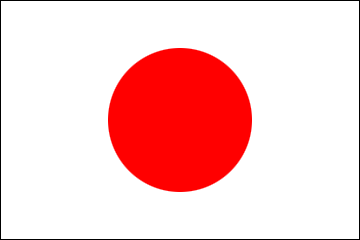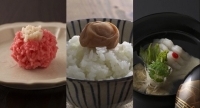Japanese Kitchen
2020/9/9
Our eighth Japanese Kitchen article, moves across Japan's main island of Honshu from Gifu to another landlocked region - Tochigi Prefecture. Tochigi Prefecture attracts many visitors in particular to Nikko, home to a number of magnificent historic shrines and temples which are registered as UNESCO World Heritage sites.
Gyoza (Dumplings)
by Ayako Hitomi
originally published in September 2014
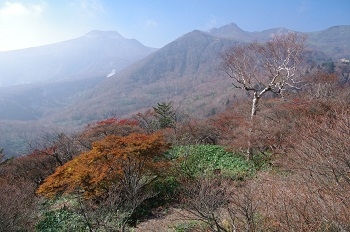 Tochigi Prefecture is located 100km to the north of Tokyo. This is a prefecture richly endowed with nature. My home town is in the north of the prefecture, called Nasu-Shiobara City. This city attracts many tourists throughout the year, as a summer retreat, for its beautiful coloured leaves in autumn, and for skiing and hot spring in winter.
Tochigi Prefecture is located 100km to the north of Tokyo. This is a prefecture richly endowed with nature. My home town is in the north of the prefecture, called Nasu-Shiobara City. This city attracts many tourists throughout the year, as a summer retreat, for its beautiful coloured leaves in autumn, and for skiing and hot spring in winter.
Our specialty dish is dumpling (gyoza). This month, I would like to introduce to you Utsunomiya gyoza, which the people of Tochigi believe is the best gyoza in Japan.
Tochigi gyoza gained popularity in the 1990s when a survey conducted by the Ministry of Internal Affairs and Communications revealed that the people of Utsunomiya (the capital of Tochigi Prefecture) eat more gyoza than any other parts of the country. Upon hearing this survey result, a group of local gyoza restaurant owners established the Ustunomiya Gyoza Association and began actively promoting local gyoza. Thanks to their effort, Utsunomiya gyoza became increasingly popular not only in Utsunomiya or Tochigi Prefecture but also in other parts of Japan. People from outside Tochigi began to visit Utsunomiya, attracted by now nationally popular Utsunomiya gyoza!
It was however not an easy journey for us. The popularity of Utunomiya gyoza experienced a crisis in 2011 when Japan was hit by the Great East Earthquake. Due to its geographical proximity to Fukushima Prefecture (whose nuclear power plant suffered damage in the aftermath of the earthquake), the number of visitors to Tochigi declined. Also amid growing concern about radioactive contamination, people began to question the safety of our local food including gyoza. As a result, Utunomiya lost the status of the most popular gyoza city in Japan. This was a very sad experience for the people of Tochigi, but they did not give up! In fact, they made a tremendous amount of effort in making a public appeal to the broader public that Tochigi’s food products are safe to eat (and indeed they are safe). Also the Tochigi people did not forget to eat gyoza themselves; how can you recommend your food to others when you are not eating it? All these efforts were rewarded as Utsunomiya regained the number 1 status in national gyoza rankings in 2013! I am very proud of their achievements.
If you want to get a sense of how passionate we are about gyoza, come to the West exist of the Utsunomiya Train Station where you can find the Gyoza Statue. This is one of the most popular tourist destinations. Whenever you visit, you can find people taking photo, or sometimes even see people praying in front of the statue. Actually, I myself also prayed before taking university entrance exam. The result? Of course, I passed! We also organize a Gyoza Festival every autumn where you can try Utsunomiya Gyoza cooked by popular local gyoza restaurants.
Now, there are many ways to cook Utsunomiya gyoza. Some of my friends like to eat succulent fried gyoza, while others prefer boiled ones. You can also have them steamed. It is really up to you, but in whatever way it is cooked, we in Tochigi always eat with vinegar. But don’t worry, you are more than welcome to use soy sauce or chili oil. After all, we just want you to enjoy eating our gyoza!
Photo: Autumn foliage in Nasu (©Yasufumi Nishi/©JNTO)
originally published in September 2014
 Tochigi Prefecture is located 100km to the north of Tokyo. This is a prefecture richly endowed with nature. My home town is in the north of the prefecture, called Nasu-Shiobara City. This city attracts many tourists throughout the year, as a summer retreat, for its beautiful coloured leaves in autumn, and for skiing and hot spring in winter.
Tochigi Prefecture is located 100km to the north of Tokyo. This is a prefecture richly endowed with nature. My home town is in the north of the prefecture, called Nasu-Shiobara City. This city attracts many tourists throughout the year, as a summer retreat, for its beautiful coloured leaves in autumn, and for skiing and hot spring in winter.Our specialty dish is dumpling (gyoza). This month, I would like to introduce to you Utsunomiya gyoza, which the people of Tochigi believe is the best gyoza in Japan.
Tochigi gyoza gained popularity in the 1990s when a survey conducted by the Ministry of Internal Affairs and Communications revealed that the people of Utsunomiya (the capital of Tochigi Prefecture) eat more gyoza than any other parts of the country. Upon hearing this survey result, a group of local gyoza restaurant owners established the Ustunomiya Gyoza Association and began actively promoting local gyoza. Thanks to their effort, Utsunomiya gyoza became increasingly popular not only in Utsunomiya or Tochigi Prefecture but also in other parts of Japan. People from outside Tochigi began to visit Utsunomiya, attracted by now nationally popular Utsunomiya gyoza!
It was however not an easy journey for us. The popularity of Utunomiya gyoza experienced a crisis in 2011 when Japan was hit by the Great East Earthquake. Due to its geographical proximity to Fukushima Prefecture (whose nuclear power plant suffered damage in the aftermath of the earthquake), the number of visitors to Tochigi declined. Also amid growing concern about radioactive contamination, people began to question the safety of our local food including gyoza. As a result, Utunomiya lost the status of the most popular gyoza city in Japan. This was a very sad experience for the people of Tochigi, but they did not give up! In fact, they made a tremendous amount of effort in making a public appeal to the broader public that Tochigi’s food products are safe to eat (and indeed they are safe). Also the Tochigi people did not forget to eat gyoza themselves; how can you recommend your food to others when you are not eating it? All these efforts were rewarded as Utsunomiya regained the number 1 status in national gyoza rankings in 2013! I am very proud of their achievements.
If you want to get a sense of how passionate we are about gyoza, come to the West exist of the Utsunomiya Train Station where you can find the Gyoza Statue. This is one of the most popular tourist destinations. Whenever you visit, you can find people taking photo, or sometimes even see people praying in front of the statue. Actually, I myself also prayed before taking university entrance exam. The result? Of course, I passed! We also organize a Gyoza Festival every autumn where you can try Utsunomiya Gyoza cooked by popular local gyoza restaurants.
Now, there are many ways to cook Utsunomiya gyoza. Some of my friends like to eat succulent fried gyoza, while others prefer boiled ones. You can also have them steamed. It is really up to you, but in whatever way it is cooked, we in Tochigi always eat with vinegar. But don’t worry, you are more than welcome to use soy sauce or chili oil. After all, we just want you to enjoy eating our gyoza!
Photo: Autumn foliage in Nasu (©Yasufumi Nishi/©JNTO)
Gyoza recipe
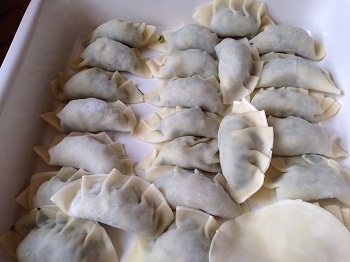 Ingredients
Ingredients
- Gyoza skins
- Chinese cabbage (or cabbage)
- Chinese leek
- Pork mince
- Garlic and ginger (grated)
- Salt and pepper, sesame oil
- Salad oil
- Gyoza dipping sauce: vineger, soy sauce, chill Oil
Instructions
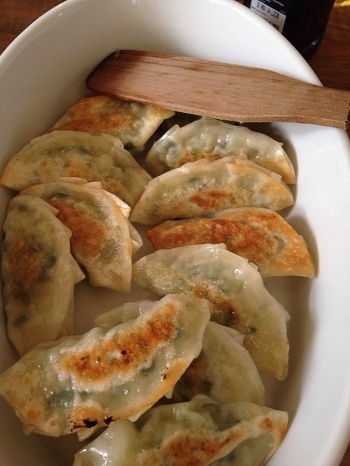 1. For the the pork filling, chop the vegetables and mix all of the filling ingredients together in a large mixing bowl until well combined (before you mix veg and mince, I would recommend you drain the vegetables to remove any excess liquid). Season well with salt and freshly ground black pepper. Add a small amount of sesame oil to taste.
1. For the the pork filling, chop the vegetables and mix all of the filling ingredients together in a large mixing bowl until well combined (before you mix veg and mince, I would recommend you drain the vegetables to remove any excess liquid). Season well with salt and freshly ground black pepper. Add a small amount of sesame oil to taste.
2. To assemble the dumplings, hold a gyoza skin in the palm of your hand and add one teaspoon of the filling mixture. Wet the edges with a little water using your fingertip and seal the dumpling, pinching along the edges to create a pleated fan effect.
3. To cook the dumplings, heat the vegetable oil in a large frying pan with a lid over a high heat. Arrange the gyoza in the pan, leaving space between each one, and fry for 2-3 minutes, or until the bottoms are golden-brown. Take care as they will burn quickly. Add HOT water to the pan, cover with the lid and steam the dumplings until the filling is completely cooked through (take the lid off after a few minutes).
 1. For the the pork filling, chop the vegetables and mix all of the filling ingredients together in a large mixing bowl until well combined (before you mix veg and mince, I would recommend you drain the vegetables to remove any excess liquid). Season well with salt and freshly ground black pepper. Add a small amount of sesame oil to taste.
1. For the the pork filling, chop the vegetables and mix all of the filling ingredients together in a large mixing bowl until well combined (before you mix veg and mince, I would recommend you drain the vegetables to remove any excess liquid). Season well with salt and freshly ground black pepper. Add a small amount of sesame oil to taste.2. To assemble the dumplings, hold a gyoza skin in the palm of your hand and add one teaspoon of the filling mixture. Wet the edges with a little water using your fingertip and seal the dumpling, pinching along the edges to create a pleated fan effect.
3. To cook the dumplings, heat the vegetable oil in a large frying pan with a lid over a high heat. Arrange the gyoza in the pan, leaving space between each one, and fry for 2-3 minutes, or until the bottoms are golden-brown. Take care as they will burn quickly. Add HOT water to the pan, cover with the lid and steam the dumplings until the filling is completely cooked through (take the lid off after a few minutes).
